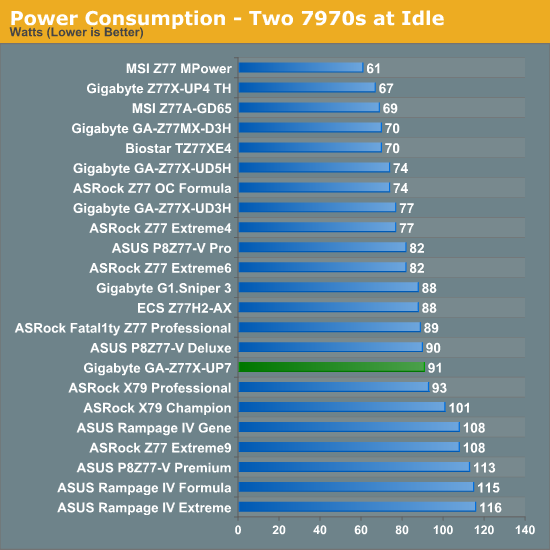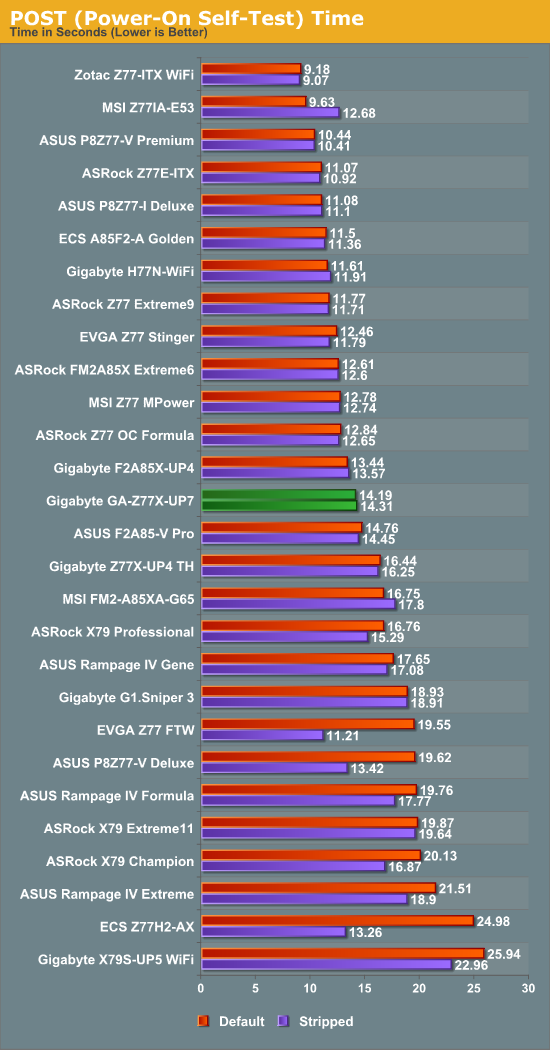Gigabyte Z77X-UP7 Review: OC Oriented Orange Overkill
by Ian Cutress on March 1, 2013 10:30 AM EST- Posted in
- Motherboards
- Intel
- Gigabyte
- Z77
Many thanks to...
We must thank the following companies for kindly donating hardware for our test bed:
Thank you to OCZ for providing us with the 1250W Gold Power Supply and USB testing SSD
Thank you to Micron for providing us with the SATA SSD
Thank you to G.Skill for providing us with the memory kits
Thank you to ASUS for providing us the AMD GPUs and some IO Testing kit
Thank you to ECS for providing us the NVIDIA GPUs
Test Setup
| Test Setup | |
| Processor |
Intel Core i7-3770K Retail 4 Cores, 8 Threads, 3.5 GHz (3.9 GHz Turbo) |
| Motherboards |
ASRock Z77 Extreme4 ASRock Z77 Extreme6 ASRock Z77 Extreme9 ASRock Z77 OC Formula ASRock Fatal1ty Z77 Professional ASUS P8Z77-V Pro ASUS P8Z77-V Deluxe ASUS P8Z77-V Premium Biostar TZ77XE4 ECS Z77H2-AX EVGA Z77 FTW Gigabyte GA-Z77X-UD3H Gigabyte GA-Z77X-UD5H Gigabyte GA-Z77MX-D3H Gigabyte G1.Sniper 3 Gigabyte GA-Z77X-UP4 TH Gigabyte GA-Z77X-UP7 MSI Z77 MPower MSI Z77A-GD65 |
| Cooling | Thermalright TRUE Copper |
| Power Supply | OCZ 1250W Gold ZX Series |
| Memory |
GSkill RipjawsZ 4x4 GB DDR3-2400 9-11-11 Kit GSkill TridentX 2x4 GB DDR3-2666 11-13-13 Kit |
| Memory Settings | XMP (2400 9-11-11) |
| Video Cards |
ASUS HD7970 3GB ECS GTX 580 1536MB |
| Video Drivers |
Catalyst 12.3 NVIDIA Drivers 296.10 WHQL |
| Hard Drive | Micron RealSSD C300 256GB |
| Optical Drive | LG GH22NS50 |
| Case | Open Test Bed - CoolerMaster Lab V1.0 |
| Operating System | Windows 7 64-bit |
| USB 2/3 Testing | OCZ Vertex 3 240GB with SATA->USB Adaptor |
Power Consumption
Power consumption was tested on the system as a whole with a wall meter connected to the OCZ 1250W power supply, while in a dual 7970 GPU configuration. This power supply is Gold rated, and as I am in the UK on a 230-240 V supply, leads to ~75% efficiency > 50W, and 90%+ efficiency at 250W, which is suitable for both idle and multi-GPU loading. This method of power reading allows us to compare the power management of the UEFI and the board to supply components with power under load, and includes typical PSU losses due to efficiency. These are the real world values that consumers may expect from a typical system (minus the monitor) using this motherboard.
While this method for power measurement may not be ideal, and you feel these numbers are not representative due to the high wattage power supply being used (we use the same PSU to remain consistent over a series of reviews, and the fact that some boards on our test bed get tested with three or four high powered GPUs), the important point to take away is the relationship between the numbers. These boards are all under the same conditions, and thus the differences between them should be easy to spot.

The Z77X-UP7 is stuck between a rock and a hard place on power usage. The IR3550s it uses are very efficient for power, but having 32 on the board (and 8 working at idle) causes a little more power usage than the other OC boards across our range of tests.
POST Time
Different motherboards have different POST sequences before an operating system is initialized. A lot of this is dependent on the board itself, and POST boot time is determined by the controllers on board (and the sequence of how those extras are organized). As part of our testing, we are now going to look at the POST Boot Time - this is the time from pressing the ON button on the computer to when Windows starts loading. (We discount Windows loading as it is highly variable given Windows specific features.) These results are subject to human error, so please allow +/- 1 second in these results.

Boot time for the UP7 does not touch our artificial ‘sub-12 second’ ideal line, but at 14 seconds is the fasted Gigabyte Z77 board we have tested.










41 Comments
View All Comments
IanCutress - Friday, March 1, 2013 - link
This is an 1155 product, as shown by the fact that it uses the Z77 chipset and I use the i7-3770K to test it. The original OC board was 1366.sherlockwing - Friday, March 1, 2013 - link
What are you smoking, this board is called Z77X-UP7, it is a LGA1155 Z77 board. Where did you get LGA1366 from?dawp - Friday, March 1, 2013 - link
probably from the X58A-OC reference in the article.Samus - Friday, March 1, 2013 - link
Don't hate.xdunpealx - Friday, March 1, 2013 - link
580s? who no 660 or 660ti or even 670s?sna2 - Friday, March 1, 2013 - link
Hi ,we all know this PLX is not real .. the CPU itself supports fixed number of PCIe lanes ... the PLX switches between them thats all ..
If you want to spend that amount of money on a motherboard , then just get an LGA 2011 CPU with C606 or X79 chipset ..
what is the point of all this ? any one who wants 3 or 4 ways SLI , can pay for the LGA 2011 CPU , actually this motherboard is more expensive than the X79 ones.
ANAND , we need you to test PLX VS no PLX performance !
THANKS !
IanCutress - Sunday, March 3, 2013 - link
Hi sna2,If you would direct your attention to:
(a) the GPU results page where I showcase PLX vs. no PLX performance on a single GPU and
(b) my initial discussion on the PLX chip (http://www.anandtech.com/show/6170) where we discuss what the advantages and disadvantages to how the PLX chip actually works.
Yes overall the lanes are limited to 16 upstream and downstream to the GPU, but when dealing with multi-GPU configurations, most data transfer between GPUs (important for gaming and compute) via the PLX, not via the CPU, making the increased lane count between the GPUs more important than the upstream/downstream via the CPU.
Without the PLX, manufacturers are limited to x8/x4/x4 GPU setups with Ivy Bridge CPUs, where compute platforms, some gaming setups, or even a mix with RAID cards and sound cards need the lane allocation to work the way the user wants.
Ian
CNP-Keythai - Saturday, March 2, 2013 - link
I think the board looks cool, price is good too. Would recommend it.kmmatney - Saturday, March 2, 2013 - link
I'm going to buy it just for use around Halloween.Beenthere - Saturday, March 2, 2013 - link
The "orange" in addition to making this mobo look like a Halloween joke... increase sales to the technically challenged. When you hear people talk about how they like the color of the hardware box, RAM, PSU, mobo, etc. it's because they have missed the plot all together.